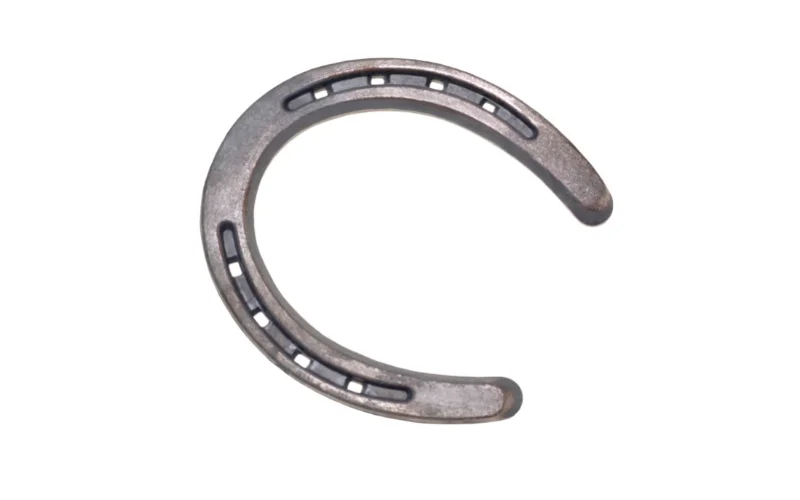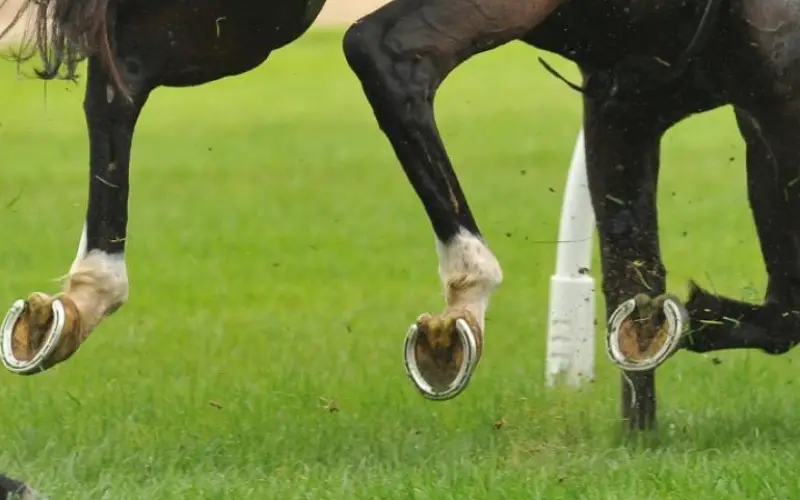If you live in the country, you probably have horses in your stable that serve not just as farm animals but also as a means of transportation and are even more common these days as a pet.
Horses are lovely animals that have always been man’s companions on long journeys and on the farm from historical times.
It is becoming increasingly uncommon to see a horse without metal-fitted hooves that serve as a protective covering.
This is because many people have seen how important it is for their horses and how much better and comfortable the horses are when they are fitted with these horseshoes.
What Is Horseshoe

Horseshoes are fabricated products usually made of metal, even though some are made of plastic, and other synthetic materials are designed to protect horse hoof from wear and injuries. These U-shaped horseshoes can be nailed or glued to the insensitive hoof wall.
These horseshoes come in a wide variety of styles and materials designed for different types of horses, depending on their work.
Steel is the commonest material used to make horseshoes for horses involved in sports like polo, western riding, show jumping, and the like because steel is a very strong material.
Aluminum shoes are lighter and are used by horses for races because the lightness of the Aluminum horseshoes makes certain types of moving faster.
What Are Horseshoes For?
Horses in the wild do well without horseshoes because they are in the arid steppe climate, which suits them perfectly, and they do not need any protection from very hot or cold weather.
In the wild, horses cover long distances, but they usually do this at a slow speed that does not affect their hooves like we have today when horses run long distances at unbelievable speed.
There are a few reasons why horseshoes are now a must for every horse, including:
1. Protection From Stress
The hooves of horses can be subjected to so much stress that will cause them to wear out, especially with the added weight that a rider, loads, carts, and wagon places on the horseback, borne by the hooves. So, a horseshoe protects the hooves from all that stress.
2. For Correction
There are customized horseshoes designed to help horses with bone or muscular problems in their feet be corrected. These horseshoes have shapes, weight, and thickness that can affect the horse’s gait significantly.
3. Traction
There are different designs of horseshoes that are meant to give traction to horses for different activities.
For instance, traction devices are fitted in horses to walk on ice: borium; horseshoe stud is used for the muddy or slick condition, carbide-tipped road nails and rims are useful for performance horses.
4. Manipulation of the Horse’s Gait
Performance horses are judged based on their gait; different horseshoes can enhance the natural gait of the horses and hence help them perform better.
5. Weakness
Horses involved in races can get weaknesses in their foot, and a horseshoe can help these horses walk better.
What Do Horseshoes Do
Horseshoes protect horses’ hooves from stress, injury, and adverse weather like snow and very hot desert ground.
It is the same reason we wear shoes; the comfort that shoes give our legs as we walk in the snow or on very hot summer days is what horseshoes do for horses.
They also help weak horses to walk better while correcting the malfunction of the hooves of other horses’ hooves.
Performance horses also benefit from these horseshoes because it enhances their walk, making them perform better.
Types of Horseshoes
There are different types of horseshoes, including:
- The regular horseshoes: this is also known as the keg shoe, and it is the most common horseshoe that horses wear. They are U-shaped they offer support to the hooves during regular riding.
- The Rim shoes are similar to the regular horseshoes; the difference is that they have a wide groove that allows the horses to get a little more traction; they are best for sports activities where the horse needs to make quick speed turns.
- Bar shoes: this horseshoe look is the shape of an oval with edges that tend to look like a hexagon, and it has an extra bar on the back of the shoe that supports the horse’s heels.
- Egg bar: as the name suggests, this horseshoe is shaped like an egg, used for horses with navicular disease. This shoe provides more support to the back of the hoof and leg extending beyond the legs.
- Heart bar: this horseshoe looks somewhat like a heart and is used for horses that have laminitis. They provide support to the back of the horse’s hooves.
What Are Horseshoes Made Of?
The material that a horseshoe is made of depends on the shoe’s function and the horse’s job. This is because the horseshoe material affects the way the horses will perform.
Most horseshoes are made of Aluminum or Steel, even though a few are made of plastic or other synthetic materials.
1. Steel
This is the best material for horseshoes meant for horses who do high-impact work like sports because steel is sturdier and heavier. Activities that involve a lot of knee action also prefer horseshoes that are made of steel.
2. Aluminum
They make lighter horseshoes and hence need to be replaced more often. Aluminum horseshoes allow horses to stretch more through the shoulder, which is very important for show horses.
3. Plastic
Plastic horseshoes only became popular a couple of decades ago because the manufacturers claim they reduce concussion, feel more natural to the horses, are lightweight, and improve traction. They are usually glued to the horse hooves or nailed in like the traditional horseshoes.
4. Integrated Shoes
Some horses tend to lose their shoes too often or those who can’t wear the standard horseshoes; for these categories of horses, synthetic materials are used to make a horseshoe that is a replica of a horse hoof. These high-tech horseshoes can also have some segments of metals to stabilize the shoes.
5. Composite Shoes
These horseshoes were designed to correct the problems encountered with plastic shoes; hence, you will find horseshoes made of more than one material like steel, plastic, mesh, and what have you. These products are lightweight yet sturdy and do not damage the horses’ feet.
How To Maintain a Horseshoe Set?
Some tips will prove helpful in maintaining your horse’s horseshoes, and they include:
- Schedule regular trimming or shoeing with your farrier as often as is necessary. On average, a horse needs to see the farrier every 4 to 6 weeks, all things being equal, except if there are issues before that.
- Always maintain a good hoof balance. Dynamic hoof balance is based on how the hoof of the horse is when it is moving. A horse hoof should always land flat, side to side, and on the heel to toe.
- Provide proper shoeing for different weather and footing condition.
- Always ensure that you give an adequate and prompt treatment of the horses, especially the feet, when injury or diseases occur.
- The place of horse nutrition as a means of keeping the hooves healthy can never be overemphasized. So always ensure that you maintain proper nutrition for your horses.
Conclusion
Horseshoes are now an integral part of a horse’s life because they protect their feet, which is an important part of their anatomy.
After all, the legs of a horse are what the voice of a musician is to him or what the leg of an athlete is to her, hence keeping the horse’s hooves healthy, free of injuries, disease, and stress is very important because it is what gives a horse its value
So. While choosing the material for your horse’s horseshoes, be they Aluminum, Steel, plastic, or what have you, remember to factor in the function of the shoes and the activities your horse will be involved in. But by and large, a horse whose feet are well protected is a horse that will stay healthy and last longer for you.
You May Also Like:
- How Far Can Raccoons Jump
- What Sorts of Food Does Backyard Lizard Eat?
- Can You Eat Squirrel From Your Backyard
- Do Skunks Climb Trees or Fences?
We trust this article helped you determine if you can shoot a possum in your backyard. You may also want to check if you can shoot a possum in your backyard.
Thanks for taking the time to read our article, and we hope you find it helpful. Would you mind leaving a comment below if you have any suggestions?
Kindly reach out to people by sharing this post on social media.
If you liked this article, then please follow us on Facebook, Instagram, and Pinterest.

